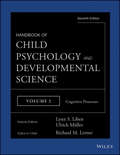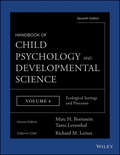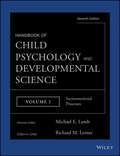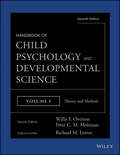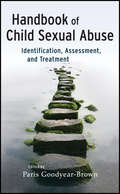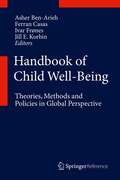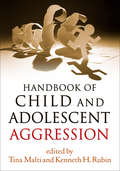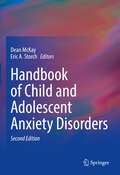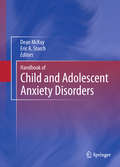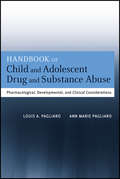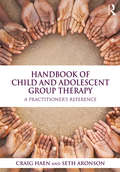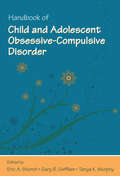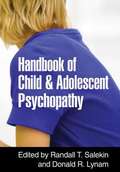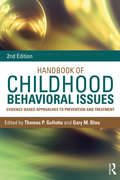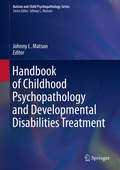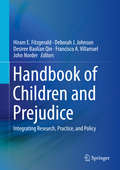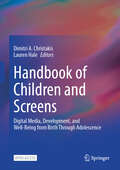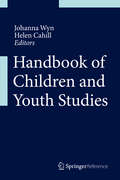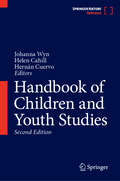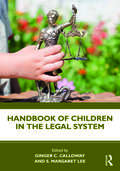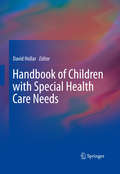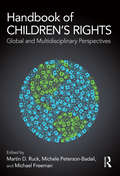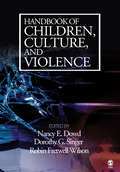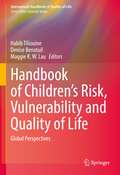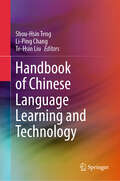- Table View
- List View
Handbook of Child Psychology and Developmental Science, Cognitive Processes: Theory And Method
by Richard M. Lerner Lynn S. Liben Ulrich MuellerThe essential reference for human development theory, updated and reconceptualized The Handbook of Child Psychology and Developmental Science, a four-volume reference, is the field-defining work to which all others are compared. First published in 1946, and now in its Seventh Edition, the Handbook has long been considered the definitive guide to the field of developmental science. Volume 2: Cognitive Processes describes cognitive development as a relational phenomenon that can be studied only as part of a larger whole of the person and context relational system that sustains it. In this volume, specific domains of cognitive development are contextualized with respect to biological processes and sociocultural contexts. Furthermore, key themes and issues (e.g., the importance of symbolic systems and social understanding) are threaded across multiple chapters, although every each chapter is focused on a different domain within cognitive development. Thus, both within and across chapters, the complexity and interconnectivity of cognitive development are well illuminated. Learn about the inextricable intertwining of perceptual development, motor development, emotional development, and brain development Understand the complexity of cognitive development without misleading simplification, reducing cognitive development to its biological substrates, or viewing it as a passive socialization process Discover how each portion of the developmental process contributes to subsequent cognitive development Examine the multiple processes – such as categorizing, reasoning, thinking, decision making and judgment – that comprise cognition The scholarship within this volume and, as well, across the four volumes of this edition, illustrate that developmental science is in the midst of a very exciting period. There is a paradigm shift that involves increasingly greater understanding of how to describe, explain, and optimize the course of human life for diverse individuals living within diverse contexts. This Handbook is the definitive reference for educators, policy-makers, researchers, students, and practitioners in human development, psychology, sociology, anthropology, and neuroscience.
Handbook of Child Psychology and Developmental Science, Ecological Settings and Processes: Ecological Settings And Processes
by Richard M. Lerner Marc H. Bornstein Tama LeventhalThe essential reference for human development theory, updated and reconceptualized The Handbook of Child Psychology and Developmental Science, a four-volume reference, is the field-defining work to which all others are compared. First published in 1946, and now in its Seventh Edition, the Handbook has long been considered the definitive guide to the field of developmental science. Volume 4: Ecological Settings and Processes in Developmental Systems is centrally concerned with the people, conditions, and events outside individuals that affect children and their development. To understand children's development it is both necessary and desirable to embrace all of these social and physical contexts. Guided by the relational developmental systems metatheory, the chapters in the volume are ordered them in a manner that begins with the near proximal contexts in which children find themselves and moving through to distal contexts that influence children in equally compelling, if less immediately manifest, ways. The volume emphasizes that the child's environment is complex, multi-dimensional, and structurally organized into interlinked contexts; children actively contribute to their development; the child and the environment are inextricably linked, and contributions of both child and environment are essential to explain or understand development. Understand the role of parents, other family members, peers, and other adults (teachers, coaches, mentors) in a child's development Discover the key neighborhood/community and institutional settings of human development Examine the role of activities, work, and media in child and adolescent development Learn about the role of medicine, law, government, war and disaster, culture, and history in contributing to the processes of human development The scholarship within this volume and, as well, across the four volumes of this edition, illustrate that developmental science is in the midst of a very exciting period. There is a paradigm shift that involves increasingly greater understanding of how to describe, explain, and optimize the course of human life for diverse individuals living within diverse contexts. This Handbook is the definitive reference for educators, policy-makers, researchers, students, and practitioners in human development, psychology, sociology, anthropology, and neuroscience.
Handbook of Child Psychology and Developmental Science, Socioemotional Processes: Socioemotional Processes
by Richard M. Lerner Michael E. LambThe essential reference for human development theory, updated and reconceptualized The Handbook of Child Psychology and Developmental Science, a four-volume reference, is the field-defining work to which all others are compared. First published in 1946, and now in its Seventh Edition, the Handbook has long been considered the definitive guide to the field of developmental science. Volume 3: Social, Emotional, and Personality Development presentsup-to-date knowledge and theoretical understanding of the several facets of social, emotional and personality processes. The volume emphasizes that any specific processes, function, or behavior discussed in the volume co-occurs alongside and is inextricably affected by the dozens of other processes, functions, or behaviors that are the focus of other researchers' work. As a result, the volume underscores the importance of a focus on the whole developing child and his or her sociocultural and historical environment. Understand the multiple processes that are interrelated in personality development Discover the individual, cultural, social, and economic processes that contribute to the social, emotional, and personality development of individuals Learn about the several individual and contextual contributions to the development of such facets of the individual as morality, spirituality, or aggressive/violent behavior Study the processes that contribute to the development of gender, sexuality, motivation, and social engagement The scholarship within this volume and, as well, across the four volumes of this edition, illustrate that developmental science is in the midst of a very exciting period. There is a paradigm shift that involves increasingly greater understanding of how to describe, explain, and optimize the course of human life for diverse individuals living within diverse contexts. This Handbook is the definitive reference for educators, policy-makers, researchers, students, and practitioners in human development, psychology, sociology, anthropology, and neuroscience.
Handbook of Child Psychology and Developmental Science, Theory and Method
by Richard M. Lerner Peter C. Molenaar Willis F. OvertonThe essential reference for human development theory, updated and reconceptualized The Handbook of Child Psychology and Developmental Science, a four-volume reference, is the field-defining work to which all others are compared. First published in 1946, and now in its Seventh Edition, the Handbook has long been considered the definitive guide to the field of developmental science. Volume 1, Theory and Method, presents a rich mix of classic and contemporary theoretical perspectives, but the dominant views throughout are marked by an emphasis on the dynamic interplay of all facets of the developmental system across the life span, incorporating the range of biological, cognitive, emotional, social, cultural, and ecological levels of analysis. Examples of the theoretical approaches discussed in the volume include those pertinent to human evolution, self regulation, the development of dynamic skills, and positive youth development. The research, methodological, and applied implications of the theoretical models discussed in the volume are presented. Understand the contributions of biology, person, and context to development within the embodied ecological system Discover the relations among individual, the social world, culture, and history that constitute human development Examine the methods of dynamic, developmental research Learn person-oriented methodological approaches to assessing developmental change The scholarship within this volume and, as well, across the four volumes of this edition, illustrate that developmental science is in the midst of a very exciting period. There is a paradigm shift that involves increasingly greater understanding of how to describe, explain, and optimize the course of human life for diverse individuals living within diverse contexts. This Handbook is the definitive reference for educators, policy-makers, researchers, students, and practitioners in human development, psychology, sociology, anthropology, and neuroscience.
Handbook of Child Sexual Abuse: Identification, Assessment, and Treatment
by Paris Goodyear-BrownThe field of child sexual abuse has experienced an explosion of research, literature, and enhanced treatment methods over the last thirty years. Representing the latest refinements of thought in this field, Handbook of Child Sexual Abuse: Identification, Assessment, and Treatment combines the most current research with a wealth of clinical experience. The contributing authors, many of whom are pioneers in their respective specialties, include researchers and clinicians, forensic interviewers and law enforcement professionals, caseworkers and victim advocates, all of whom do the work of helping children who have been sexually victimized. Offering a snapshot of the state of the field as it stands today, Handbook of Child Sexual Abuse explores a variety of issues related to child sexual abuse, from identification, assessment, and treatment methods to models for implementation and prevention, including: The impact of sexual abuse on the developing brain The potential implications of early sexual victimization Navigating the complexities of multidisciplinary teams Forensic interviewing and clinical assessment Treatment options for children who have traumagenic symptoms as a response to their sexual victimization Treating children with sexual behavior problems and adolescents who engage in illegal sexual behavior Secondary trauma and vicarious traumatization Cultural considerations and prevention efforts Edited by a leader in the field of child therapy, this important reference equips helping professionals on the front lines in the battle against child sexual abuse—not merely with state-of-the-art knowledge—but also with a renewed vision for the importance of their role in the shaping of our culture and the healing of victimized children.
Handbook of Child Well-Being
by Ivar Frønes Jill E. Korbin Ferran Casas Asher Ben-AriehThe well-being of children represents a challenge not yet fully confronted and The Handbook of Child Well-being supplies its readers with a thorough overview of the complexities and implications regarding the scientific and practical pursuit of children's well-being. The handbook addresses the concept of well-being through an in-depth analysis of the perspectives and vocabularies of various disciplines such as, philosophy, theology, psychology and sociology. It covers important issues in child well-being and the problems of the general politics of well-being as well as the implementation of interventional programs and measures. In addition the handbook deals with the methods of measuring well-being for a scientifically grounded understanding and also for policy-making. The interdisciplinary set up of the handbook makes it a unique work that offers readers from a vast scope of child-related disciplines and professions a profound overview of the complexities and implications of the scientific and practical pursuit of children s well-being. "
Handbook of Child and Adolescent Aggression
by Tina Malti Kenneth H. Rubin Tracy VaillancourtPresenting cutting-edge work from leading scholars, this authoritative handbook reviews the breadth of current knowledge on aggression from infancy through adolescence. The volume explores the forms and functions of aggression and the multiple factors that contribute to its emergence, development, and consequences, including genetic and biological influences, temperament, family dynamics, peer relations, and social inequality. It provides up-to-date perspectives on problems such as disruptive and defiant behaviors, bullying (including cyberbullying), social aggression, and youth violence, and examines relations between aggression and normative social–emotional and social-cognitive development. It also discusses the opposite end of the spectrum, including kindness and prosocial behaviors. Identifying important implications for practice and policy, contributors describe effective approaches to screening, assessment, and intervention in family, school, community, and clinical settings.
Handbook of Child and Adolescent Anxiety Disorders
by Eric A. Storch Dean McKayThe Second Edition of the handbook incorporates notable research advances throughout its comprehensive, up-to-date examination of this diverse and maturing field. Integrative state-of-the-art models document the complex interplay of risk and protective factors and other variables contributing to normal and pathological development. New and updated chapters describe current refinements in assessment methods and offer the latest research findings from neuroscience. In addition, the Second Edition provides readers with a detailed review across the spectrum of salient topics, from the effects of early deprivation to the impact of puberty. As the field continues to shift from traditional symptom-based concepts of pathology to a contemporary, dynamic paradigm, the Second Edition addresses such key topics pertinent to childhood anxiety as: · Early childhood disorders, including failure to thrive and attachment disorders. · Aggression, ADHD, and other disruptive conditions. · Developmental models of depression, anxiety, self-injury/suicide, and OCD. · The autism spectrum and other chronic developmental disorders. · Child maltreatment and trauma disorders. The Handbook of Child and Adolescent Anxiety Disorders, Second Edition of the handbook is a discipline-defining, forward-looking, essential resource for researchers, clinicians, scientist-practitioners, and graduate students in such fields as developmental psychology, child and adolescent psychiatry, social work, child and school psychology, educational psychology, and pediatrics.
Handbook of Child and Adolescent Anxiety Disorders
by Dean Mckay Eric A. StorchIs it school refusal or separation anxiety disorder? Can preschoolers have panic attacks? Does food neophobia really exist? For readers seeking ways to improve assessment, case conceptualization, or treatment plans as well as a more general understanding of anxiety disorders among children, the Handbook of Child and Adolescent Anxiety Disorders addresses these and many other complex issues. A straightforward companion to the diagnostic manuals, this volume crosses theoretical boundaries to describe in depth the wide range of children's anxiety disorders and to explain the developmental nuances that separate them from their adult analogues. Coverage includes: Diagnostic and etiological models of children's anxiety disorders (i.e., genetic, cognitive-behavioral, taxonomic, neuropsychological, dimensional). Differential diagnosis guidelines for generalized anxiety disorder (GAD), phobic conditions, obsessive-compulsive disorder (OCD), and posttraumatic stress disorder (PTSD) in youth. Ancillary factors in child and adolescent anxiety (e.g., personality, temperament, parenting issues, and comorbid conditions). Psychological, pharmacological, and combined treatments for childhood anxiety disorders. Special populations and emerging areas of interest, including anxiety disorders in the contexts of chronic health problems and developmental disabilities. The Handbook of Child and Adolescent Anxiety Disorders is a must-have reference for researchers, clinicians, and graduate students in psychology, psychiatry, social work and counseling as well as allied professionals in hospitals, community mental health centers, schools, and private practice.
Handbook of Child and Adolescent Drug and Substance Abuse
by Louis A. Pagliaro Ann Marie PagliaroSelected by Choice as a 2013 Outstanding Academic Title
Handbook of Child and Adolescent Group Therapy: A Practitioner’s Reference
by Craig Haen Seth AronsonThis handbook describes in detail different contemporary approaches to group work with children and adolescents. Further, this volume illustrates the application of these models to work with the youth of today, whether victims of trauma, adolescents struggling with LGBT issues, or youth with varying common diagnoses such as autism spectrum disorders, depression, and anxiety. It offers chapters presenting a variety of clinical approaches written by experts in these approaches, from classic (play therapy and dialectical behavior therapy) to cutting-edge (attachment-based intervention, mindfulness, and sensorimotor psychotherapy). Because of its broad scope, the book is suitable for a wide audience, from students to first-time group leaders to seasoned practitioners.
Handbook of Child and Adolescent Obsessive-Compulsive Disorder
by Eric A. Storch Gary R. Geffken Tanya K. MurphyPreviously considered a rare condition among children and adolescents, recent research on obsessive-compulsive disorder (OCD) has indicated an increased prevalence among this age group, insofar as it is now considered one of the most common of all psychiatric illnesses affecting youth. Handbook of Child and Adolescent Obsessive-Compulsive Disorder
Handbook of Child and Adolescent Psychopathy
by Randall Salekin Donald LynamThis comprehensive handbook synthesizes the rapidly growing research base on child and adolescent psychopathy: its nature, causes, development, assessment, and treatment. The editors and contributors are leading authorities who review state-of-the-art empirical findings and weigh in on pressing questions, such as how the disorder should be conceptualized in youth and how to evaluate it in clinical and forensic contexts. Available assessment instruments and intervention approaches are critically examined. Etiological theories are presented that shed light on a range of potential causal mechanisms, including genetics, brain functioning, temperament, family processes, and other factors.
Handbook of Childhood Behavioral Issues: Evidence-Based Approaches to Prevention and Treatment
by Thomas P. Gullotta Gary M. BlauThis handbook highlights present-day information and evidence-based knowledge in the field of children’s behavioral health to enable practitioners, families, and others to choose and implement one of many intervention approaches provided. Using a standardized format, best practices for the prevention and treatment of many childhood behavioral disorders are identified based on current research, sound theory, and behavioral trial studies. This revision includes an integration of the DSM-5 diagnostic manual and new chapters on childhood psychosis and military families, and a thorough updating of the research in the previous edition.
Handbook of Childhood Psychopathology and Developmental Disabilities Treatment (Autism and Child Psychopathology Series)
by Johnny L. MatsonThis handbook explores the rapid growth in childhood developmental disabilities (DD) treatments. It reviews current evidence-based treatments for common psychopathologies and developmental disorders and evaluates the strengths of the treatments based on empirical evidence. Spanning infancy through the transition to young adulthood, chapters provide definitions, etiologies, prevalence, typical presentation and variants, assessment and diagnostic information, and age considerations. Chapters also review established and emerging psychological approaches and pharmacotherapies for cognitive, behavioral, emotional, medical, academic, and developmental issues as diverse as mood disorders, the autism spectrum, memory problems, feeding disorders, Tourette syndrome, and migraines. The wide range of topics covered aids practitioners in working with the complexities of young clients’ cases while encouraging further advances in an increasingly relevant field. Topics featured in this handbook include:An introduction to Applied Behavior Analysis.Parent training interventions.Treatment strategies for depression in youth.Assessment and treatment of self-injurious behaviors in children with DD. Treatment approaches to aggression and tantrums in children with DD.Interventions for children with eating and feeding disorders. The Handbook of Childhood Psychopathology and Developmental Disabilities Treatment is a must-have resource for researchers, graduate students, clinicians, and related therapists and professionals in clinical child and school psychology, pediatrics, social work, developmental psychology, behavioral therapy/rehabilitation, child and adolescent psychiatry, and special education.
Handbook of Children and Prejudice: Integrating Research, Practice, and Policy
by Deborah J. Johnson Hiram E. Fitzgerald Desiree Baolian Qin Francisco A. Villarruel John NorderThis handbook examines the effects and influences on child and youth development of prejudice, discrimination, and inequity as well as other critical contexts, including implicit bias, explicit racism, post immigration processes, social policies, parenting and media influences. It traces the impact of bias and discrimination on children, from infancy through emerging adulthood with implications for later years. The handbook explores ways in which the expanding social, economic, and racial inequities in society are linked to increases in negative outcomes for children through exposure to adverse childhood experiences (ACEs). Chapters examine a range of ACEs – low income, separation/divorce, family substance abuse and mental illness, exposure to neighborhood and/or domestic violence, parental incarceration, immigration and displacement, and parent loss through death. Chapters also discuss discrimination and prejudice within the adverse experiences of African American, Asian American, European American, Latino, Native American, Arab American, and Sikh as well as LGBTQ youth and non-binary children. Additionally, the handbook elevates dynamic aspects of resilience, adjustment, and the daily triumphs of children and youth faced with issues related to prejudice and differential treatment.Topics featured in the Handbook include:The intergenerational transmission of protective parent responses to historical trauma.The emotional impact of the acting-white accusation.DREAMers and their experience growing up undocumented in the USA.Online racial discrimination and its relation to mental health and academic outcomes.Teaching strategies for preventing bigoted behavior in class.Emerging areas such as sociopolitical issues, gender prejudice, and dating violence. The Handbook of Children and Prejudice is a must-have resource for researchers, graduate students, clinicians, therapists, and other professionals in clinical child and school psychology, social work, public health, developmental psychology, pediatrics, family studies, juvenile justice, child and adolescent psychiatry, and educational psychology.
Handbook of Children and Screens: Digital Media, Development, and Well-Being from Birth Through Adolescence
by Dimitri A. Christakis Lauren HaleThis open access handbook synthesizes the current research about the impacts of digital media on children across development. Drawing on the expertise of scientists and researchers as well as clinicians and practitioners, the book summarizes research through interdisciplinary expert reviews. First, it addresses the cognitive, physical, mental, and psychosocial impacts on infants, children, and adolescents. Next, the book explores how media influences relationships, family, culture, and society. Finally, it examines the impacts of specific digital domains pertinent to youth, including education technology, video gaming, and emerging technologies. Chapters employ a parallel structure, including background on the topic, summary of the current state of the research, future research directions, and recommendations for relevant stakeholders. The volume examines the timely issue of optimal child development in an increasingly digital age, offering innovative approaches to establish a solid and robust scientific foundation for this field of study as well as evidence-based action for adults who support positive youth development. Key areas of coverage include: • Cognition and brain development. • Physical and mental health. • Problematic uses of the internet. • Race. • Gender and sexuality. • Parenting in the digital age. • Cyberbullying and digital cruelty. • Media policy. The Handbook of Children and Screens is a must-have resource for researchers, professors, and graduate students as well as clinicians, therapists, educators, and related professionals in clinical child, school, and developmental psychology, social work, public health, epidemiology, neuroscience, human development and family studies, social psychology, sociology, and communication. This is an open access book.
Handbook of Children and Youth Studies
by Johanna Wyn Helen CahillChallenging theoretical and conceptual orthodoxies, this book presents interdisciplinary thinking and critical perspectives on childhood and youth, to address the emerging consensus that boundaries between childhood, youth and adulthood are blurred.
Handbook of Children and Youth Studies
by Johanna Wyn Helen Cahill Hernán CuervoThis second edition of the handbook gives a new scientific perspective to youth and childhood studies as multi scientific and interdisciplinary subjects which as such have not yet found their own framing in a particular discipline. It provides theoretical and methodological key debates and issues that develop and add an understanding of childhood and youth research discipline from a broader perspective. The Handbook on Children and Youth Studies draws on current thinking, but also challenges theoretical and conceptual orthodoxies in the field, drawing on interdisciplinary thinking and critical perspectives. It focuses on childhood and youth to address the emerging consensus that the boundaries between childhood, youth and adulthood are blurred. The view that defining youth and childhood largely in terms of problem topics is out dated. Instead, the handbook focuses on 16 themes that are open to international perspectives and to different conceptual approaches. Each theme is edited by a pair of field editors, thereby capturing a plurality of views. The 16 themes as a starting point are globally timely and they need scientific debates on the boundaries between childhoods, youth and adulthood. This handbook will meet the needs of childhood and youth researchers and the academics in the field. It recognizes the changing social context of the lives of children and young people, while developing theoretical frameworks and discussing about the core substantive issues of Children and Youth Studies.
Handbook of Children in the Legal System
by Ginger C. Calloway S. Margaret LeeThis handbook brings together the relevant literature on children and their developmental characteristics, the legal venues in which they may appear, and the systemic issues practitioners must consider to provide a thorough guide to working with children in the legal system. Featuring contributions from leading mental health and legal experts, chapters start with an overview and history of the juvenile justice system along with discussion of critical developmental areas imperative to consider for work with children, and idiosyncratic issues that arise. The book ends with a case presentation section that illustrates the varied roles and venues in which children appear in the legal system. An extended bibliography provides additional resources and literature to investigate specific topics in greater length. This accessible and useable guide is designed to appeal to a broad range of people encountering children in the legal system, including social workers, psychologists, psychiatrists, attorneys, and judges. It will also benefit professions such as law enforcement as well as probation officers, child protective workers, school personnel, and medical personnel.
Handbook of Children with Special Health Care Needs
by David HollarChildren with chronic conditions, developmental disorders, and birth defects represent a sizeable minority of American children--as many as one in five. Often their families have financial or other issues limiting their access to appropriate care, thus limiting their adult prospects as well. Compounding the problem, many valuable resources concerning this population are difficult to access although they may be critical to the researchers, practitioners, and policymakers creating standards for quality care and services. In response, the Handbook of Children with Special Health Care Needs assembles research, applied, and policy perspectives reflecting the range of children's problems requiring special services. Widely studied conditions (e.g., communication disorders, substance abuse) and those receiving lesser attention (e.g., tuberculosis) are covered, as are emerging ideas such as the "medical home" concept of continuity of care. Its interdisciplinary outlook makes the Handbook of Children with Special Health Care Needs a vital, forward-looking text for developmental psychologists, pediatricians, early childhood and special education researchers and practitioners, disability researchers, policymakers, and advocates, and providers for children with special health care needs.
Handbook of Children's Rights: Global and Multidisciplinary Perspectives
by Michael Freeman Martin D. Ruck Michele Peterson-BadaliWhile the notion of young people as individuals worthy or capable of having rights is of relatively recent origin, over the past several decades there has been a substantial increase in both social and political commitment to children’s rights as well as a tendency to grant young people some of the rights that were typically accorded only to adults. In addition, there has been a noticeable shift in orientation from a focus on children’s protection and provision to an emphasis on children’s participation and self-determination. With contributions from a wide range of international scholars, the Handbook of Children’s Rights brings together research, theory, and practice from diverse perspectives on children’s rights. This volume constitutes a comprehensive treatment of critical perspectives concerning children’s rights in their various forms. Its contributions address some of the major scholarly tensions and policy debates comprising the current discourse on children’s rights, including the best interests of the child, evolving capacities of the child, states’ rights versus children’s rights, rights of children versus parental or family rights, children as citizens, children’s rights versus children’s responsibilities, and balancing protection and participation. In addition to its multidisciplinary focus, the handbook includes perspectives from social science domains in which children’s rights scholarship has evolved largely independently due to distinct and seemingly competing assumptions and disciplinary approaches (e.g., childhood studies, developmental psychology, sociology of childhood, anthropology, and political science). The handbook also brings together diverse methodological approaches to the study of children’s rights, including both quantitative and qualitative perspectives, and policy analysis. This comprehensive, cosmopolitan, and timely volume serves as an important reference for both scholarly and policy-driven interest in the voices and perspectives of children and youth.
Handbook of Children, Culture, and Violence
by Dr Dorothy G. Singer Robin Fretwell Wilson Professor Nancy E. DowdThe Handbook of Children, Culture, and Violence provides a comprehensive, interdisciplinary examination of childhood violence that considers children as both consumers and perpetrators of violence, as well as victims of it. This Handbook is the first single volume to consider situations when children are responsible for violence, rather than focusing exclusively on occasions when they are victimized.
Handbook of Children’s Risk, Vulnerability and Quality of Life: Global Perspectives (International Handbooks of Quality-of-Life)
by Habib Tiliouine Maggie K. W. Lau Denise BenatuilThis handbook makes a major contribution to the growing international research and policy interest in children’s experienced well-being or quality of life in childhood, linking it to ongoing research on children’s risk and vulnerability. The editors and contributors adopt the broader concept of ‘risk’ in addition to ‘vulnerability’. Not much work considers the connections between risks that children experience and their quality of life. In examining children’s quality of life, the chapters discuss various issues of risk and vulnerability that may affect their lives and also how the quality of childhood might be enhanced and maintained even in the face of these factors. The chapters discuss experiences of violence and abuse; access to basic services such as housing, health and education; and children’s vulnerability due to broader external factors such as war, conflict, and environmental events. The volume also includes the impacts of new technologies on children and the consequent risks and vulnerabilities they may face, alongside the benefits.This important volume brings together a diverse range of perspectives from established experts and emerging scholars in these fields of work. It covers a wide range of geographical and cultural contexts, and includes theoretical, empirical, policy and practice-based contributions. This handbook is a natural first point of reference for academics and policy professionals interested in quality of life, well-being, and children's rights.
Handbook of Chinese Language Learning and Technology
by Shou-Hsin Teng Li-Ping Chang Te-Hsin LiuThis handbook explores quantitative linguistics, pedagogy, and Mandarin language acquisition in an integrated fashion and helps readers grasp how insights from quantitative linguistics can shed light on Mandarin language acquisition. It focuses on issues related to language processing, learning, and teaching and how these aspects are affected or enhanced by corpus-based and computational linguistics. By following a data-driven approach, the handbook demonstrates how theoretical problems in the acquisition of Chinese can be resolved with empirical evidence. The book serves as an essential resource for students and researchers wishing to explore the fascinating field of Chinese language processing and acquisition.
